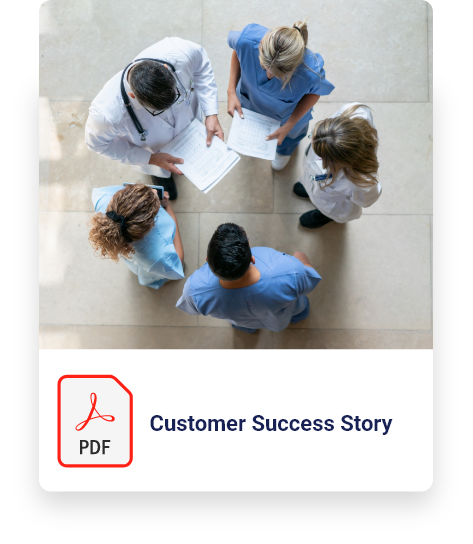CUSTOMER SUCCESS STORY
PRODUCT INFORMATION MANAGEMENT (PIM)
Medical device manufacturers, suppliers, GPOs and hospitals often manage many thousands of product records in their e-catalogs and item master files, with hundreds of attributes per product. Maintaining product master data can be a daunting task, which requires deep product knowledge, and which consumes an enormous amount of time & effort. Product Information Management (PIM) systems are designed to handle the diverse product attribution required by different product categories, different catalog distribution channels, trading partners and regulatory agencies. Innovit PIM solutions are designed to help solve a variety of product data problems, but PIM can also help improve business analytics to optimize strategic supply, especially during crises like the Covid-19 pandemic.
A TOP-RANKED HOSPITAL SYSTEM
The Customer
One of the highest ranked, non-profit hospital systems in the world, committed to clinical excellence, education and research and providing expert, whole-person healthcare to everyone who needs healing.

The Challenges
As the healthcare industry continues to evolve and transform, this hospital realized it needed to improve the sourcing and management of product master data from medical products suppliers in order to further reduce supply chain costs and to optimize clinical performance. They realized there was an opportunity to drive master data management best practices that help address their most pressing business needs:
• Centralize product master data from multiple, disparate sources
• Establish an accurate and up-to-date single source of truth (“golden record”)
• Automate downloading of data from the GDSN and the FDA’s GUDID
• Source product catalogs electronically via their GPO (Vizient) using a workflow-controlled, data governance process
• Control soaring costs for contracted supplies
• Visibility of contracted vendors’ catalogs – quickly and easily
• Eliminate ad-hoc sourcing to provide improved buying power
• Publish validated, cleansed, and rich product data to their Magento eCommerce system for patients and affiliated hospitals to order medical supplies

“We were at risk to miss the UDI Class II deadline of
September 2016 and our team in Australia suggested
Innovit. After an extensive RFP process involving numerous
solutions, the path forward was clear.”
The Solutions
Innovit PIM (Product Information Management)
After an extensive, global search for a solution provider,
Innovit’s PIM was chosen based upon:
• Innovit’s in-depth knowledge of healthcare manufacturers and industry supply chain challenges
• Innovit’s PIM capabilities and modern user interface
• Value-added consultative service model
• Proven results with existing healthcare customers


The Results
Improving Strategic Supply
The functionality delivered by Innovit’s PIM enabled this hospital to consolidate all catalog content from a variety of sources into a centralized repository. They automated master data maintenance workflows and identified survivorship attributes for products to improve data quality management which fueled supply chain efficiencies beyond the initial project scope.
Use Cases
Use Case #1
Standardizing product data for substitutes analysis
CHALLENGE
Healthcare providers are interested in maximizing clinical per formance and improving patient experience. So, choosing the right medical product for a given procedure is critical for providers to do their work effectively and deliver the best outcomes for patient wellness. And while there are indeed products from different suppliers that seem to do the same job from a clinical perspective, clinicians must be assured that these products are truly “clinically-equivalent” substitutes. But researching substitute products can be a painstaking task which invariably takes providers away from spending more time with their patients.
SOLUTION
Using Innovit’s PIM, the hospital’s clinical team was able to use standardized, “extended” clinical data attributes and trusted product data within their supply chain operations to reduce the time & effort for finding clinically equivalent substitute products when the primary product is not available. This new capability and speed enabled the hospital to reduce cost of supply by quickly identifying substitutes and alternative suppliers at lower prices – without compromising product quality and clinical efficacy.
Use Case #2
Facilitating clinical analysis to ensure consistent categorization
CHALLENGE
There are currently over 20 different Classification and Nomenclature Systems used across the world for the classification of products in the healthcare sector which are used to group like products such as Medical Devices versus Pharmaceutical, Drugs versus capital equipment etc. Examples of classification systems include GMDN, UNSPSC, GPC, eClass, CND, EMDN and ATC among others.
Each of these classification systems are designed for a different purpose to assist organizations with, for example:- Spend Analysis, Financial Analysis, Clinical Investigations, Performance Studies, Procurement and Sourcing. Unfortunately, it can be a tremendous challenge for hospitals to do any kind of analysis since suppliers use different standards, different versions of the same standard, and varying allocations / interpretations of these category codes – and this was especially problematic during a pandemic. The lack of categorization standards hit hardest with COVID-19. As a leader in healthcare, this hospital wanted to know the number of PPE products in total, their inventory location and stock available at each location. They saw the need for an industry standard to categorize medical products for healthcare procurement and supply chain management.
SOLUTION
Using Innovit’s PIM, the hospital’s master data team improved categorization of products through standardizing category codes and category attribution for different purposes, and applying different category coding stan dards for the same product depending on which industry standard was relevant for that task. In addition, they were able to group/categorize products clinically similar/equivalent, ultimately facilitating effective and accurate clinical analysis.
Use Case #3
Guaranteeing supply for critical items during extraordinary events (e.g. COVID-19)
CHALLENGE
Healthcare providers must be prepared to tackle supply shortages or supply chain delays especially during a natural disaster or worldwide pandemic. Doing so requires deep insight into inventories and where those products are manufactured. For example, ‘Country of Origin’ data is needed to better predict / estimate / determine potential medical device shortages especially during times of crisis. Having this knowledge about source of supply/manufacture enables a healthcare provider to anticipate shortage of supply and quickly adapt without affecting its clinical practice and their need for critical supplies. They are better positioned to shift sourcing to different suppliers across different locations.
SOLUTION
Using Innovit’s PIM, the hospital’s master data team set rules and workflows to better identify ‘Country of Origin’ information to help secure supply for critical items during extraordinary events (for example, rubber gloves, tubing, masks, sanitizers and sterilizers etc.).
Use Case #4
Triggering automated workflows in EHR systems with accurate clinical data to ensure patient safety and transparency
CHALLENGE
Electronic Medical Records (EMR) and Electronic Health Records (EHRs) are designed to help clinicians improve patient care and help healthcare providers deliver better health outcomes. They improve the ability to diagnose diseases and reduce — even prevent — medical errors. For example, the EMR/EHR system keeps a record of each patient’s medications or allergies and will automatically check for problems whenever a new medication is prescribed. If a potential conflict exists, the clinician will be alerted immediately on screen.
Automated workflows are required to trigger critical safety alerts for caregivers when treating their patients. These automated workflows depend on vitally important product attributes about medicines and medical devices to be ‘validated & accurate’; and to be passed automatically & reliably from clinical data sources into the EMR or EHR via a PIM system. Examples of such attributes include:- ‘latex free’, ‘MRI safe’, certain allergens & ingredients etc.
SOLUTION
Using Innovit’s PIM, the hospital team was able to collect key product attributes about drugs and medical devices from various data sources like the FDA’s GUDID, First Databank, GDSN, Vizient etc. and validate this product data. Once the hospital’s master data stewards complete their review and approval of the product attributes, this vital product master data is then syndicated to the hospital’s EHR system to trigger automated workflows.

CONCLUSION
A critical success factor for any healthcare provider is having the right medical products, at the right time, in the right place, for physicians to provide the services that their patient’s demand. This is only possible with high-quality product data – rich, validated, authentic, accurate, up-to-date and complete. Leveraging product master data via Innovit’s PIM solutions for a highly efficient supply chain helps ensure that every patient has a seamless healthcare experience with a positive outcome.

Related case studies
The Risks of Last-Minute Device Registration – And How to Avoid Them
The European Union in recognizing the pivotal role played by the EUDAMED system in safeguarding patient safety and efficiency of medical devices within the market…
EUDAMED Go-Live Announcement: Streamlined UDI Data Submission using Innovit EUDAMED Connector
The European Union in recognizing the pivotal role played by the EUDAMED system in safeguarding patient safety and efficiency of medical devices within the market…
Updated Timeline: Mandatory Use by Q4 2025 – Current planning for gradual roll out and modules’ functionality view
The European Union in recognizing the pivotal role played by the EUDAMED system in safeguarding patient safety and efficiency of medical devices within the market…



